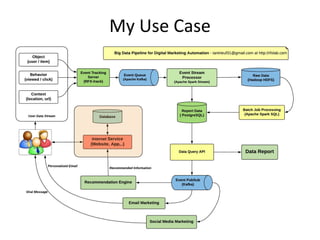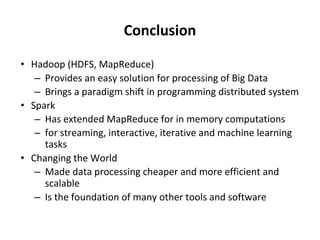Apache Hadoop and Spark: Introduction and Use Cases for Data Analysis
- 1. Apache Hadoop and Spark: Introduction and Use Cases for Data Analysis http://www.bigdatavietnam.org
- 2. Outline • Growth of big datasets • Introduction to Apache Hadoop and Spark for developing applications • Components of Hadoop, HDFS, MapReduce and HBase • Capabilities of Spark and the differences from a typical MapReduce solution • Some Spark use cases for data analysis
- 3. Growth of Big Datasets • Internet/Online Data – Clicks – Searches – Server requests – Web logs – Cell phone logs – Mobile GPS locations – User generated content – Entertainment (YouTube, Netflix, Spotify, …) • Healthcare and Scientific Computations – Genomics, medical images, healthcare data, billing data • Graph data – Telecommunications network – Social networks (Facebook, Twitter, LinkedIn, …) – Computer networks • Internet of Things – RFID – Sensors • Financial data
- 4. Data • The Large Hadron Collider produces about 30 petabytes of data per year • Facebook’s data is growing at 8 petabytes per month • The New York stock exchange generates about 4 terabyte of data per day • YouTube had around 80 petabytes of storage in 2012 • Internet Archive stores around 19 petabytes of data
- 5. Cloud and Distributed Computing • The second trend is pervasiveness of cloud based storage and computational resources – For processing of these big datasets • Cloud characteristics – Provide a scalable standard environment – On-demand computing – Pay as you need – Dynamically scalable – Cheaper
- 6. Data Processing and Machine learning Methods • Data processing (third trend) – Traditional ETL (extract, transform, load) – Data Stores (HBase, ……..) – Tools for processing of streaming, multimedia & batch data • Machine Learning (fourth trend) – Classification – Regression – Clustering – Collaborative filtering Big Datasets Machine Learning Distributed Computing Working at the Intersection of these four trends is very exciting and challenging and require new ways to store and process Big Data Data Processing ETL (extract, transform, load)
- 7. Hadoop Ecosystem • Enable Scalability – on commodity hardware • Handle Fault Tolerance • Can Handle a Variety of Data type – Text, Graph, Streaming Data, Images,… • Shared Environment • Provides Value – Cost
- 8. Hadoop Ecosystem A B C D Layer Diagram
- 9. Apache Hadoop Basic Modules • Hadoop Common • Hadoop Distributed File System (HDFS) • Hadoop YARN • Hadoop MapReduce MapReduce Distributed Processing HDFS Distributed File System (Storage) HBase Non-relational Database Yarn Resource Manager Pig Scripting Hive SQL Like Query Other Modules: Zookeeper, Impala, Oozie, etc. Others Distributed Processing Spark, Storm, Tez, etc.
- 10. Hadoop HDFS • Hadoop distributed File System (based on Google File System (GFS) paper, 2004) – Serves as the distributed file system for most tools in the Hadoop ecosystem – Scalability for large data sets – Reliability to cope with hardware failures • HDFS good for: – Large files – Streaming data • Not good for: – Lots of small files – Random access to files – Low latency access Single Hadoop cluster with 5000 servers and 250 petabytes of data
- 11. Design of Hadoop Distributed File System (HDFS) • Master-Slave design • Master Node – Single NameNode for managing metadata • Slave Nodes – Multiple DataNodes for storing data • Other – Secondary NameNode as a backup
- 12. HDFS Architecture NameNode DataNode DataNode DataNode DataNode DataNode DataNode DataNode DataNode Secondary NameNodeClient Heartbeat, Cmd, Data NameNode keeps the metadata, the name, location and directory DataNode provide storage for blocks of data
- 13. HDFS File B1 B2 B3 B4 Node B1 Node Node B2 Node B1Node Node B2B3 Node Node Node B4 B3 B1 B4 Node Node Node B3 B4 B2B1 What happens; if node(s) fail? Replication of Blocks for fault tolerance
- 14. HDFS • HDFS files are divided into blocks – It’s the basic unit of read/write – Default size is 64MB, could be larger (128MB) – Hence makes HDFS good for storing larger files • HDFS blocks are replicated multiple times – One block stored at multiple location, also at different racks (usually 3 times) – This makes HDFS storage fault tolerant and faster to read
- 15. Few HDFS Shell commands Create a directory in HDFS • hadoop fs -mkdir /user/godil/dir1 List the content of a directory • hadoop fs -ls /user/godil Upload and download a file in HDFS • hadoop fs -put /home/godil/file.txt /user/godil/datadir/ • hadoop fs -get /user/godil/datadir/file.txt /home/ Look at the content of a file • Hadoop fs -cat /user/godil/datadir/book.txt Many more commands, similar to Unix
- 16. HBase • NoSQL data store build on top of HDFS • Based on the Google BigTable paper (2006) • Can handle various types of data • Stores large amount of data (TB,PB) • Column-Oriented data store • Big Data with random read and writes • Horizontally scalable
- 17. HBase, not to use for • Not good as a traditional RDBMs (Relational Database Model) – Transactional applications – Data Analytics • Not efficient for text searching and processing
- 18. MapReduce: Simple Programming for Big Data • MapReduce is simple programming paradigm for the Hadoop ecosystem • Traditional parallel programming requires expertise of different computing/systems concepts – examples: multithreads, synchronization mechanisms (locks, semaphores, and monitors ) – incorrect use: can crash your program, get incorrect results, or severely impact performance – Usually not fault tolerant to hardware failure • The MapReduce programming model greatly simplifies running code in parallel – you don't have to deal with any of above issues – only need to create, map and reduce functions Based on Google’s MR paper (2004)
- 19. Apply function Map: Apply a function to all the elements of List list1=[1,2,3,4,5]; square x = x * x list2=Map square(list1) print list2 -> [1,4,9,16,25] Reduce: Combine all the elements of list for a summary list1 = [1,2,3,4,5]; A = reduce (+) list1 Print A -> 15 Map Reduce Paradigm • Map and Reduce are based on functional programming Input OutputMap Reduce
- 20. MapReduce Word Count Example
- 21. Shortcoming of MapReduce • Forces your data processing into Map and Reduce – Other workflows missing include join, filter, flatMap, groupByKey, union, intersection, … • Based on “Acyclic Data Flow” from Disk to Disk (HDFS) • Read and write to Disk before and after Map and Reduce (stateless machine) – Not efficient for iterative tasks, i.e. Machine Learning • Only Java natively supported – Support for others languages needed • Only for Batch processing – Interactivity, streaming data
- 22. One Solution is Apache Spark • A new general framework, which solves many of the short comings of MapReduce • It capable of leveraging the Hadoop ecosystem, e.g. HDFS, YARN, HBase, S3, … • Has many other workflows, i.e. join, filter, flatMapdistinct, groupByKey, reduceByKey, sortByKey, collect, count, first… – (around 30 efficient distributed operations) • In-memory caching of data (for iterative, graph, and machine learning algorithms, etc.) • Native Scala, Java, Python, and R support • Supports interactive shells for exploratory data analysis • Spark API is extremely simple to use • Developed at AMPLab UC Berkeley, now by Databricks.com
- 23. Spark Uses Memory instead of Disk Iteration1 Iteration2 HDFS read Iteration1 Iteration2 HDFS read HDFS Write HDFS read HDFS Write Spark: In-Memory Data Sharing Hadoop: Use Disk for Data Sharing
- 24. Sort competition Hadoop MR Record (2013) Spark Record (2014) Data Size 102.5 TB 100 TB Elapsed Time 72 mins 23 mins # Nodes 2100 206 # Cores 50400 physical 6592 virtualized Cluster disk throughput 3150 GB/s (est.) 618 GB/s Network dedicated data center, 10Gbps virtualized (EC2) 10Gbps network Sort rate 1.42 TB/min 4.27 TB/min Sort rate/node 0.67 GB/min 20.7 GB/min Sort benchmark, Daytona Gray: sort of 100 TB of data (1 trillion records) http://databricks.com/blog/2014/11/05/spark-officially-sets-a-new-record-in-large-scale-sorting.html Spark, 3x faster with 1/10 the nodes
- 25. Apache Spark Apache Spark supports data analysis, machine learning, graphs, streaming data, etc. It can read/write from a range of data types and allows development in multiple languages. Spark Core Spark Streaming MLlib GraphX ML Pipelines Spark SQL DataFrames Data Sources Scala, Java, Python, R, SQL Hadoop HDFS, HBase, Hive, Apache S3, Streaming, JSON, MySQL, and HPC-style (GlusterFS, Lustre)
- 26. Core concepts
- 27. Resilient Distributed Datasets (RDDs) • RDDs (Resilient Distributed Datasets) is Data Containers • All the different processing components in Spark share the same abstraction called RDD • As applications share the RDD abstraction, you can mix different kind of transformations to create new RDDs • Created by parallelizing a collection or reading a file • Fault tolerant
- 28. DataFrames & Spark SQL • DataFrames (DFs) is one of the other distributed datasets organized in named columns • Similar to a relational database, Python Pandas Dataframe or R’s DataTables – Immutable once constructed – Track lineage – Enable distributed computations • How to construct Dataframes – Read from file(s) – Transforming an existing DFs(Spark or Pandas) – Parallelizing a python collection list – Apply transformations and actions
- 29. DataFrame example // Create a new DataFrame that contains “students” students = users.filter(users.age < 21) //Alternatively, using Pandas-like syntax students = users[users.age < 21] //Count the number of students users by gender students.groupBy("gender").count() // Join young students with another DataFrame called logs students.join(logs, logs.userId == users.userId, “left_outer")
- 30. RDDs vs. DataFrames • RDDs provide a low level interface into Spark • DataFrames have a schema • DataFrames are cached and optimized by Spark • DataFrames are built on top of the RDDs and the core Spark API Example: performance
- 31. Spark Operations Transformations (create a new RDD) map filter sample groupByKey reduceByKey sortByKey intersection flatMap union join cogroup cross mapValues reduceByKey Actions (return results to driver program) collect first Reduce take Count takeOrdered takeSample countByKey take save lookupKey foreach
- 32. Directed Acyclic Graphs (DAG) A B S C E D F DAGs track dependencies (also known as Lineage ) ➢ nodes are RDDs ➢ arrows are Transformations
- 33. Narrow Vs. Wide transformation A,1 A,[1,2] A,2 Narrow Wide Map groupByKey Vs.
- 34. Actions • What is an action – The final stage of the workflow – Triggers the execution of the DAG – Returns the results to the driver – Or writes the data to HDFS or to a file
- 35. Spark Workflow FlatMap Map groupbyKey Spark Context Driver Program Collect
- 36. Python RDD API Examples • Word count text_file = sc.textFile("hdfs://usr/godil/text/book.txt") counts = text_file.flatMap(lambda line: line.split(" ")) .map(lambda word: (word, 1)) .reduceByKey(lambda a, b: a + b) counts.saveAsTextFile("hdfs://usr/godil/output/wordCount.txt") • Logistic Regression # Every record of this DataFrame contains the label and # features represented by a vector. df = sqlContext.createDataFrame(data, ["label", "features"]) # Set parameters for the algorithm. # Here, we limit the number of iterations to 10. lr = LogisticRegression(maxIter=10) # Fit the model to the data. model = lr.fit(df) # Given a dataset, predict each point's label, and show the results. model.transform(df).show() Examples from http://spark.apache.org/
- 37. RDD Persistence and Removal • RDD Persistence – RDD.persist() – Storage level: • MEMORY_ONLY, MEMORY_AND_DISK, MEMORY_ONLY_SER, DISK_ONLY,……. • RDD Removal – RDD.unpersist()
- 38. Broadcast Variables and Accumulators (Shared Variables ) • Broadcast variables allow the programmer to keep a read-only variable cached on each node, rather than sending a copy of it with tasks >broadcastV1 = sc.broadcast([1, 2, 3,4,5,6]) >broadcastV1.value [1,2,3,4,5,6] • Accumulators are variables that are only “added” to through an associative operation and can be efficiently supported in parallel accum = sc.accumulator(0) accum.add(x) accum.value
- 39. Spark’s Main Use Cases • Streaming Data • Machine Learning • Interactive Analysis • Data Warehousing • Batch Processing • Exploratory Data Analysis • Graph Data Analysis • Spatial (GIS) Data Analysis • And many more
- 40. Spark Use Cases • Web Analytics – Developed a Spark based for web analytics • Social Media Sentiment Analysis – Developed a Spark based Sentiment Analysis code for a Social Media dataset
- 41. My Use Case
- 42. Spark in the Real World (I) • Uber – the online taxi company gathers terabytes of event data from its mobile users every day. – By using Kafka, Spark Streaming, and HDFS, to build a continuous ETL pipeline – Convert raw unstructured event data into structured data as it is collected – Uses it further for more complex analytics and optimization of operations • Pinterest – Uses a Spark ETL pipeline – Leverages Spark Streaming to gain immediate insight into how users all over the world are engaging with Pins—in real time. – Can make more relevant recommendations as people navigate the site – Recommends related Pins – Determine which products to buy, or destinations to visit
- 43. Spark in the Real World (II) Here are Few other Real World Use Cases: • Conviva – 4 million video feeds per month – This streaming video company is second only to YouTube. – Uses Spark to reduce customer churn by optimizing video streams and managing live video traffic – Maintains a consistently smooth, high quality viewing experience. • Capital One – is using Spark and data science algorithms to understand customers in a better way. – Developing next generation of financial products and services – Find attributes and patterns of increased probability for fraud • Netflix – leveraging Spark for insights of user viewing habits and then recommends movies to them. – User data is also used for content creation
- 44. Spark: when not to use • Even though Spark is versatile, that doesn’t mean Spark’s in-memory capabilities are the best fit for all use cases: – For many simple use cases Apache MapReduce and Hive might be a more appropriate choice – Spark was not designed as a multi-user environment – Spark users are required to know that memory they have is sufficient for a dataset – Adding more users adds complications, since the users will have to coordinate memory usage to run code
- 45. HPC and Big Data Convergence • Clouds and supercomputers are collections of computers networked together in a datacenter • Clouds have different networking, I/O, CPU and cost trade-offs than supercomputers • Cloud workloads are data oriented vs. computation oriented and are less closely coupled than supercomputers • Principles of parallel computing same on both • Apache Hadoop and Spark vs. Open MPI
- 46. HPC and Big Data K-Means example MPI definitely outpaces Hadoop, but can be boosted using a hybrid approach of other technologies that blend HPC and big data, including Spark and HARP. Dr. Geoffrey Fox, Indiana University. (http://arxiv.org/pdf/1403.1528.pdf)
- 47. Conclusion • Hadoop (HDFS, MapReduce) – Provides an easy solution for processing of Big Data – Brings a paradigm shift in programming distributed system • Spark – Has extended MapReduce for in memory computations – for streaming, interactive, iterative and machine learning tasks • Changing the World – Made data processing cheaper and more efficient and scalable – Is the foundation of many other tools and software
- 48. MapReduce vs. Spark for Large Scale Data Analysis • MapReduce and Spark are two very popular open source cluster computing frameworks for large scale data analytics • These frameworks hide the complexity of task parallelism and fault-tolerance, by exposing a simple programming API to users Tasks Word Count sort K-means Page-Rank MapReduce Spark




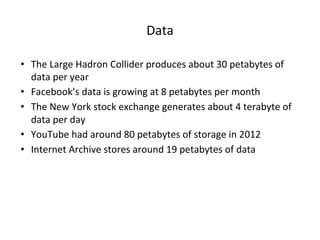
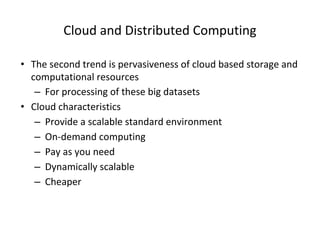


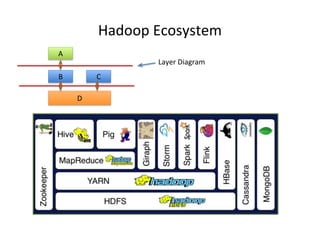










![Apply function Map:
Apply a function to all the elements of
List
list1=[1,2,3,4,5];
square x = x * x
list2=Map square(list1)
print list2
-> [1,4,9,16,25]
Reduce:
Combine all the elements of list for a
summary
list1 = [1,2,3,4,5];
A = reduce (+) list1
Print A
-> 15
Map Reduce Paradigm
• Map and Reduce are based on functional programming
Input OutputMap Reduce](https://image.slidesharecdn.com/apachehadoopandsparkintroductionandusecasesfordataanalysis-180402071127/85/Apache-Hadoop-and-Spark-Introduction-and-Use-Cases-for-Data-Analysis-19-320.jpg)
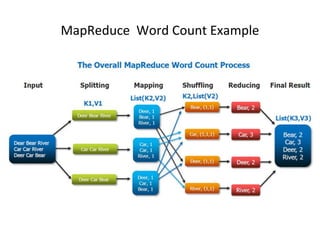

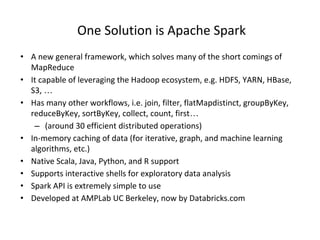
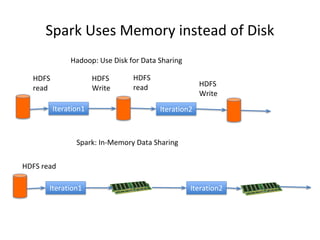


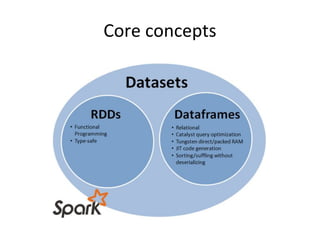


![DataFrame example
// Create a new DataFrame that contains “students”
students = users.filter(users.age < 21)
//Alternatively, using Pandas-like syntax
students = users[users.age < 21]
//Count the number of students users by gender
students.groupBy("gender").count()
// Join young students with another DataFrame called
logs
students.join(logs, logs.userId == users.userId,
“left_outer")](https://image.slidesharecdn.com/apachehadoopandsparkintroductionandusecasesfordataanalysis-180402071127/85/Apache-Hadoop-and-Spark-Introduction-and-Use-Cases-for-Data-Analysis-29-320.jpg)



![Narrow Vs. Wide transformation
A,1 A,[1,2]
A,2
Narrow Wide
Map groupByKey
Vs.](https://image.slidesharecdn.com/apachehadoopandsparkintroductionandusecasesfordataanalysis-180402071127/85/Apache-Hadoop-and-Spark-Introduction-and-Use-Cases-for-Data-Analysis-33-320.jpg)


![Python RDD API Examples
• Word count
text_file = sc.textFile("hdfs://usr/godil/text/book.txt")
counts = text_file.flatMap(lambda line: line.split(" "))
.map(lambda word: (word, 1))
.reduceByKey(lambda a, b: a + b)
counts.saveAsTextFile("hdfs://usr/godil/output/wordCount.txt")
• Logistic Regression
# Every record of this DataFrame contains the label and
# features represented by a vector.
df = sqlContext.createDataFrame(data, ["label", "features"])
# Set parameters for the algorithm.
# Here, we limit the number of iterations to 10.
lr = LogisticRegression(maxIter=10)
# Fit the model to the data.
model = lr.fit(df)
# Given a dataset, predict each point's label, and show the results.
model.transform(df).show()
Examples from http://spark.apache.org/](https://image.slidesharecdn.com/apachehadoopandsparkintroductionandusecasesfordataanalysis-180402071127/85/Apache-Hadoop-and-Spark-Introduction-and-Use-Cases-for-Data-Analysis-36-320.jpg)

![Broadcast Variables and Accumulators
(Shared Variables )
• Broadcast variables allow the programmer to keep a
read-only variable cached on each node, rather than sending
a copy of it with tasks
>broadcastV1 = sc.broadcast([1, 2, 3,4,5,6])
>broadcastV1.value
[1,2,3,4,5,6]
• Accumulators are variables that are only “added” to through
an associative operation and can be efficiently supported in
parallel
accum = sc.accumulator(0)
accum.add(x)
accum.value](https://image.slidesharecdn.com/apachehadoopandsparkintroductionandusecasesfordataanalysis-180402071127/85/Apache-Hadoop-and-Spark-Introduction-and-Use-Cases-for-Data-Analysis-38-320.jpg)


